
|

|
Prof Mahesh Rangarajan, historian and researcher, receives the TN Khoshoo Memorial Award 2014
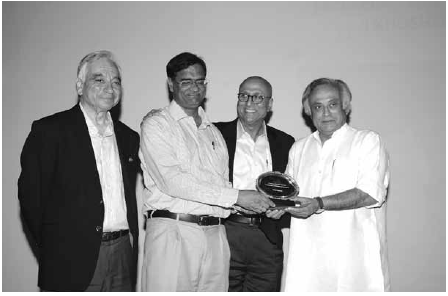
The TN Khoshoo Memorial Award recognizes outstanding
contribution in the fields of conservation and sustainable
development. It is given annually in memory of renowned
environmental scientist, the late Dr Triloki Nath Khoshoo. ATREE
organizes the award event. Dr TN Khoshoo is remembered with
affection by the founders of ATREE; he was a mentor to ATREE;
he catalyzed the formation of ATREE and influenced ATREE's
orientation as a research organization that would deliver usable
solutions to issues of environment and sustainable development.
Prof Mahesh Rangarajan, historian and researcher, and Director,
Nehru Memorial Museum and Library, New Delhi, received the
11th TN Khoshoo Memorial Award at Bangalore on 6 November
2014. The list of TN Khoshoo awardees over the years attests
to the broad and diverse ways in which academics, practitioners,
administrative officials and others are addressing issues of
environment and sustainable development. The list serves to
affirm why it is necessary to adapt an interdisciplinary approach
for addressing issues of such breadth, impacting such a diversity
of stakeholders.
Dr Bawa, President, ATREE, says, "Mahesh Rangarajan has been a
thoughtful writer and commentator on major environmental issues of our time. He has recently called
for new, more holistic approaches to
conservation."
|
|
In this year's awardee,
we have someone who has added to
our understanding of the environment
through an analysis of the history of
nature-society interactions. Professor
Rangarajan is a prolific writer, who has
explored ideas on environment through
different lenses-of history, politics
and environment-stimulating thought
on how the history of humanity's coexistence
(and conflict) with forests
and wildlife could inform current
conservation practice. Prof Rangarajan,
on receiving the award, "… This award
is less a recognition of my individual
effort as a student of history and much
more a recognition of the significance of
history and the humanistic disciplines in
the search for an environmentally sound
future. It has been my privilege to have
had exceptional teachers, colleagues,
students and citizens who have engaged
with these issues. Their work and
insight has informed not only research
and writing but the development of
environmental history in India. It is
especially humbling for me to receive
an award named after a distinguished
scientist like Dr Khoshoo."
This year, instead of a memorial lecture,
ATREE decided on a more interactive
panel discussion, which might
provoke thought on current conflicts
and conundrums impacting work on
environmental issues. The topic was
'Challenges to conservation in the
context of a pro-growth development
agenda'; the panel: Prof Rangarajan;
Praveen Bhargav, Managing Trustee,
Wildlife First; and Vidya Athreya,
Research Associate, Centre for Wildlife
Studies and Wildlife Conservation
Society – India chapter, and recipient
of the TN Khoshoo Memorial Award
in 2012. Shri Jairam Ramesh, Chair,
Future Earth Engagement Committee,
and Chief Guest for the evening
moderated the discussion. The panel
concluded that growth, for a country
|
like India, needs be rapid, inclusive and
most of all, sustainable. Ramesh said
that growth is not inclusive if it affects
livelihoods and livelihood security.
Research
A systematic revision
of the land snails of
the Western Ghats
of India
A couple of days before the close of
2014, the Natural History Museum,
London, in partner ship with ATREE,
University Museum of Zoology,
Cambridge, Chulalongkorn University,
and partners in Sri Lanka, released a
systematic guide to the land snails
of the Western Ghats. The guide is
a culmination of six years of work,
starting 2008, when the partnership
was founded. This taxonomic revision
of land snails updates The Fauna
of British India (FBI) series on land
molluscs, which was published
between 1908 and 1921, and which
is still referred to.
Terrestrial snail research is of particular
value to ecologists: land snails are one
of the most sensitive bio-indicators,
responding to changes in environment
quality (such as land degradation,
fragmentation, hydrology, climate
change and ecosystem health) by
their presence or absence; increase
or decrease in numbers, which is
recordable and measureable by
the shells they leave behind. Some
generalist species spell the state of the
environment at landscape level; others,
that occupy more specialized niches,
can flag changes at very local scales.
By the same logic, snail status might
also indicate whether conservation
strategies are effective. So the fact
|
that land snails have clocked more
recorded extinctions than all other
animal groups put together should
cause us major misgivings. According
to the authors, the speed with which
extinctions are taking place rules
out natural processes and points at
anthropogenic disturbances.
The guide presents 337 taxa, including
16 taxa that may occur in this region
since they are widespread in the rest
of the peninsula. Taxonomy is an
evolving science, with new science
providing new criteria and guidelines
to systematics: this guide presents the
nomenclature and taxonomy of snails
within a modern systematic framework.
The colour images and specimen data
of type material for all the Western
Ghats taxa, alongside distributional
data from the original literature and
comprehensive geo-referenced index
of localities for the taxa considered is
of immense value to researchers and
students.
Neelavara Ananthram Aravind, Fellow
at ATREE, has been working on land
molluscs since 2000.
Bird survey in the
Eastern Ghats
We lack basic information about the
biodiversity of the Eastern Ghats. The
Western Ghats are well known to all,
but the Eastern Ghats hardly so. It
shows how constricted the focus of
much of our ecological research and
conservation work is. The Eastern
Ghats are the hill ranges stretching
north to south across Odisha,
Telangana, Andhra Pradesh, Tamil Nadu
and Karnataka, for nearly the same
length as the Western Ghats. They are
intercepted by numerous rivers and
streams, including the vast Godavari
and Krishna and Mahanadi. Known as a
region with anti-establishment views,
despite the reduction in conflicts,
|
|
most happenings in this region often
go unnoticed. It is a place for many
indigenous communities of the region;
it is where plantations for timber and
coffee stand; it is where hunting or
poaching is obvious; it is where the
state's compensatory afforestation
programmes take place; it is where
colossal dams are being created across
most rivers which flow across them and
where mining conflicts keep arising.
It is also where a diversity of wildlife
survives despite several pressures,
including landscape fragmentation.
Published data on the birds of Eastern
Ghats has been very sparse, with the
only large spatial studies on birds
having been conducted in the 1970s
and 80s by researchers from Bombay
Natural History Society (BNHS). Other
available information is cursory or
restricted to a very small part of
the region. Recently, ATREE started
gathering baseline information on
biodiversity of the northern Eastern
Ghats based on several surveys and
visits. Articles about ATREE's visits
(Eastern Ghats' Tragedy in Sanctuary
Asia December 2013) to this area got
us noticed by other organizations.
Consequently, a coordinated weeklong
bird survey was initiated in
December, with support from the Indian
Bird Conservation Network (IBCN),
BNHS, and Samata. We decided to
cover as much of the region's habitats
in this limited time with six separate
teams composed of experienced
birders, young ecologists and local
volunteers interested in reaching out
for the cause.
There were limitations on our
movement owing to security concerns,
and lack of road connectivity. As
the teams moved across different
forest and habitat types, the reports
expanded with notes not just on
abundance, presence or absence of
birds but also on their calls, behavior
and habitat related details. We travelled
|
through areas such as the dense
moist deciduous patches and coffee
plantations in Papikonda National Park,
the dry deciduous foothills around
Chinturu and Rekhapalli, crossed the
Godavari to look at the forest on its
south bank and the riparian routes
along the streams adjoining Sileru
river. We used the point count method
for this survey in which a transect
containing multiple points, each
separated by at least 200 meters, was
used to collect information about bird
diversity in the area. In four days, the
three teams of six surveyors walked
more than 32 trails. Local support and
experience of earlier visits to the areas
was crucial in this survey as it made
planning and managing logistics easier.
The survey also brought together
people passionate about working in
this challenging landscape.
The bird survey has helped set a
baseline to be built upon in future. We
noticed some overlapping distribution
patterns. A diverse community of
more than 150 species was found from
preliminary summaries. Some species,
whose distributions are disjunct from
the moist forest of the Western Ghats
and the North-Eastern areas, were
found (for example Jerdon's Baza
and Brook's Flycatcher). The nearthreatened
Malabar Pied Hornbills
were found in more than a couple
of places and in a large flock, while
common birds like the ubiquitous
black kite were not sighted.
Looking at the results of the survey,
and after observing the conditions
in the Eastern Ghats, it is clear that
anthropogenic activities are bringing
a rapid change in the landscape.
Clear-felling of forests for agriculture
and plantations has already altered
habitats available for forest dwelling
birds, and now the ongoing and
potential submergence of large areas
due to the numerous dams being
constructed is adding to it. Rampant
|
hunting of birds and animals seems to
be stimulated by market demand as
well as by existing local consumption.
Shifting cultivation is being converted
into settled agriculture through the
developments of the past decade.
All this has been making unceasing
impacts on the ecology of the land,
not just the avifauna. Hopefully, with
plans for continuing surveys and more
in-depth research in the Eastern Ghats,
we will gather enough information for a
better future of this diverse landscape.
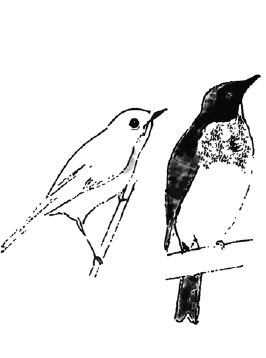
Line drawing of a flycatcher with what
seems to be the hybrid plumage of a
Tickell's/Brook's Flycatcher by Ovee
Thorat.
Read coverage in Times of India. 8
December 2014: Intensive bird survey
to map Eastern Ghats.
|
Outreach
Conservation strategy across
countries for the Critically
Endangered White-bellied
Heron
Bombay Natural History Society
and ATREE hosted a workshop in
Guwahati in order to create a meeting
opportunity for experts, government
and non-government representatives
from different countries. The objective
was to develop a cohesive transboundary
conservation strategy for
the White-bellied Heron (WBH), Ardea
insignis, also called Imperial Heron, of
which there are an only 250 adults left.
Although this heron has a range across
Bhutan, India, Myanmar and possibly
China, it occurs only patchily and at
very low densities.
A summary of outcomes of this meet:
- Each range country underscored
the need for more scientific
research in order to develop a
basic understanding of the biology,
habits and distribution of the
White-bellied Heron, which could
then provide a solid basis for its
conservation. This was agreed
upon as a major objective.

|
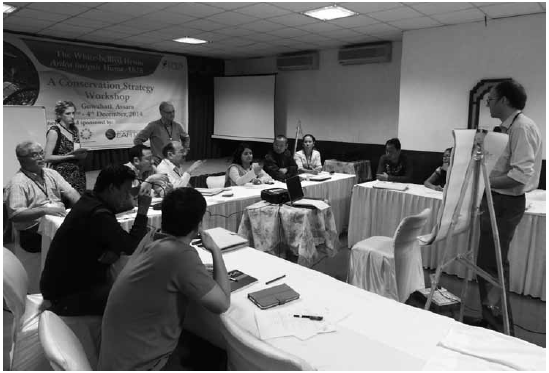
|
- Participants agreed that a further
goal should be ensuring that riverine
ecosystems are maintained in good
ecological health in the interests of
both the heron and the many rural
communities, which share land and
water with the heron.
- Finally, that each range country
ensure the highest level of legal,
enforceable protection for the
species. This could be in tandem with
efforts to sensitize society regarding
the significance of the bird as a
flagship species for the conservation
of healthy river systems.
Feedback from participants was that
it was a productive workshop, with
excellent information exchange about
this most challenging species. The
group laid out overarching as well
as range-state objectives for the
next 12 months, which they would
review at next meet. The group felt it
would be useful to establish a formal
structure to facilitate collaboration
on the species' conservation among
the range countries. Over the coming
months, the conservation strategy will
be compiled and refined, so that it may
be adopted and implemented by all
|
range country governments and their
partners.
The workshop was held over three days,
from 2-4 December, in Guwahati, Assam.
The forty one participants included field
experts, and governmental and nongovernmental
representatives from the
range countries.
See press on this meet: Experts push
for protection of herons. The Telegraph.
11 December 2014.
Niraj Kakti, Guwahati and Sarala
Khaling, Gangtok
Species depletion and
responsible fishing at
Vembanad: community
protest and action for better
governance
Vembanad lake has high deposits of
white clam, which are fossils of black
clam (Villorita cyprinoides). Only the
White Clam Co-operative Societies
have the authority to mine the fossil
deposits, and that too, only manually.
For this, the White Clam Co-operative
|
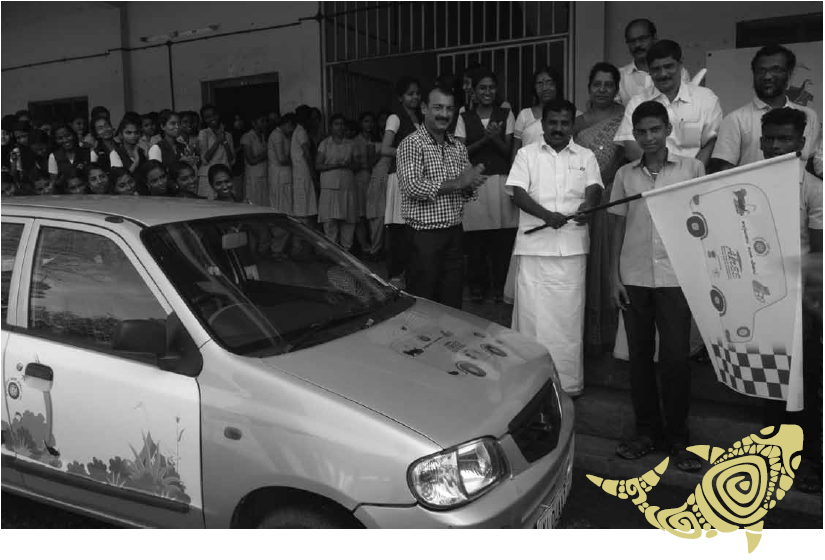 |
|
Societies have a protocol to follow:
they must first submit a mine plan to
the Department of Mining and Geology,
which, in turn, has to get permission
from the Indian Bureau of Mines. In
the white clam mine plan, it has been
clearly stated that only manual mining
can be permitted in Vembanad and its
surrounding wetlands. Over the past
few months, however, miners have
taken to illegal mechanized white clam
dredging. The Lake Protection Forums
(LPFs, which ATREE had helped found
in 2006; registered in 2009) have
protested strongly against this. The
mechanized dredging by the illegal
miners has resulted in large scale
disturbance of black clam deposits
as well as of other fishery resources.
It is expected that due to mining, the
water quality will deteriorate, with low
pH (acidic) and high TDS, which will
eventually harm fishery resources in
the lake.
|
Since the authorities did not respond,
the a Vembanad Kayal Samrekshana
Samithy (Federation of Lake Protection
Forums) organized a collective protest
against the illegal mining. More than
120 clam collectors and fisher-folk
gathered. The protest was flagged
off by environmental activist, C. R.
Neelakandan, and was presided
over by K. N. Babu, Aryad block
Panchayat member, with K. M. Poovu,
Secretary, Somyukta Vembanad Kayal
Samrekshana Samithy and Dr. Thomas
Issac, MLA, Government of Kerala,
lending their presence. After this, a
series of protests were organized by
LPFs around Vembanad Lake, which
caught the attention of the authorities.
Pearl spot, karimeen, or Etroplus
suratenis, is an important indigenous
fish. Given its dwindling numbers, the
Forest Department, led by ACF Srikumar,
brought out a fish ranching project to
|
increase karimeen numbers. This was
accomplished with the support of the
government's Kuttanad Package, and
through the participation of fishing
communities. ATREE and Vembanad
Kayal Samrekshana Samithy were the
implementation partners. So far, a total
of 30,000 karimeen juveniles have
been ranched in Vembanadat Aryad,
Shanmugham, Saryithodu, Varanam
and Kannankara. The karimeen
juveniles were provided by Matsyafed.
The fishing community expressed
satisfaction that the programme
was participatory and supported
indigenous fish species, instead of the
market-driven tilapia and rohu, which
are exotic to the Vembanad ecosystem.
|
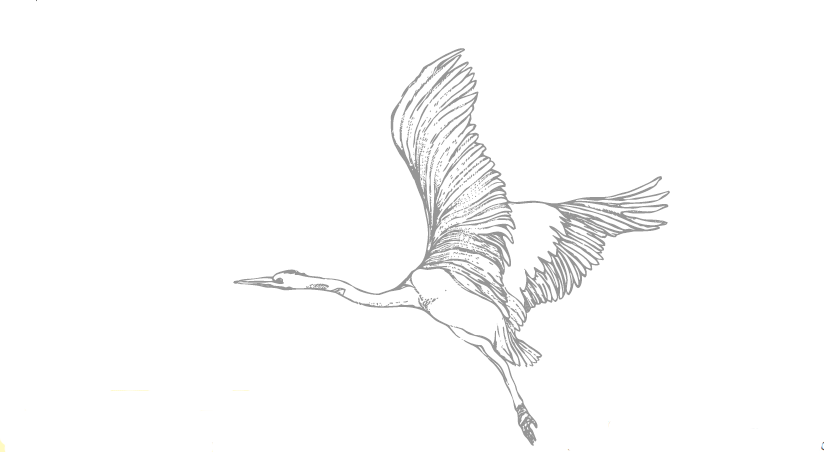 |
|
Read in press: An initiative to rescue
a threatened fish species. The Hindu.
7 December 2014. Forest Dept
launches project to boost 'Karimeen'
population in Vembanad. The New
Indian Express. 7 December 2014.
Vembanad Lake is going through drastic
ecological changes. Fish extraction is
unsustainable. The Thannermukkom
Barrage, which should be open long
and often enough to allow egress and
entry of sea water but is not, upsets
the unique wetland ecology. Pollution
from agriculture discharge, settlements
and nearby towns and from houseboats
causes further harm to this ecosystem.
The fishery resource in Vembanad
has come down drastically in the past
few decades, from 150 species to 60
species, according to the fish count
report by ATREE.
LPFs organized vallachangalla (chain of
country boats) from Thannermukkom to
Vechoor, demanding timely operation
of the barrage. The closure of barrage
has disturbed the reproduction cycle of
black clam as well as giant freshwater
prawns. The shutting of the barrage
(lobbied for by the farming sector),
obstructs migration of not only prawns
but also other fishery resources,
especially the marine fishes. ATREE has
reported that 86% of species missing
since the 1980s are marine migrants.
Ashish Mathew George, Vembanad CERC
|
New
Learning session on the
Madhav Gadgil and
Kasturirangan reports
ATREE held an internal learning session
on the two Western Ghats reports-
the Madhav Gadgil report and the
Kasturirangan report. The session had
the advantage of understanding the
reports and the responses to them, in
light of what has transpired since on
political, community and academic
fronts. Sharad Lele, Nitin Rai, Jagdish
Krishnaswamy and Siddharth Krishnan
oriented staff, faculty and students
on key features, zoning definitions,
regulatory frameworks and role of
local communities, as covered by both
reports. The session was organized by
CEPF Regional Implementation Team,
Western Ghats region coordinator,
Bhaskar Acharya.
Urbashi Pradhan, PhD batch was
resource person for the festival on
Darjeeling mandarin oranges and
large cardamom, and farmers' training
organized by Krishak Kalyan Sangathan.
Kalimpong, Darjeeling. 27 Nov-1 Oct.
Bhaskar Acharya, CEPF-ATREE Western
Ghats Programme Coordinator,
attended an informal gathering,
'People for Western Ghats' (P4WG) at
Wildernest, Chorla Ghat, Goa, in late
|
October 2014, to take stock of the effort
to Save the Western Ghats and re-think
strategies in the light of the Gadgil and
Kasturirangan reports. See more on
http://westernghatscalling. blogspot.
in/2014/12/p4wgswgm-reincranated.
html
People
Venkata Raghava Pavankumar has
joined as Senior Research Fellow, DBT –
Mystrica project, Bangalore; Mohammed
Idris, as Research Associate, Tata Social
Welfare Trust project, Bangalore.
Geethika E. and Srirama R. join the
USAID, Western Ghats team as Lab
Assistant and Programme Associate,
respectively, with Soumya K. V. and
Manasi Anand as project student
interns. Anu Radhakrishna is on the
Vembanad Bioblitz project at Allepuzah
as Field Officer. Bala Lourdu Mary J.,
HR Consultant based in Bangalore;
Meena Devi, Data Entry Operator, IDRC,
Coimbatore.
Publications
Book chapters
Swamy, S. and S. Devy. 2014. Reshaping
neighborhood parks for biodiversity
and people: a case of unsung socioecological
systems in Bangalore,
India. In: Social–ecological systems in
|
|
transition, Global Environmental Studies
(eds. Sakai, S. and C. Umetsu). Japan:
Springer.
Thomas, B. K. 2014. Monetary and
multidimensional poverty in Kerala: a
review of recent evidence. In: Kerala
economy and its emerging issues (eds.
Kurian, V. M. and R. John). Pp. 238-51.
Kottayam: SPCS.
Peer-reviewed articles
Kumara, H. N., O. Thorat, K. Santhosh,
R. Sasi and H. P. Ashwin. 2014. Small
carnivores of Biligiri Rangaswamy
Temple Tiger Reserve. Journal of
Threatened Taxa 6(12): 6534-6543.
Maurya, N. 2014. Science, society and
risk in the Anthropocene. Economic
and Political Weekly. 49(41).
Sasidharan, T. O., N. Sapna Bai, O. K.
Remadevi, M. Balachander, P. D. Rajan.
2014. Effects of different adjuvants
on the growth and sporulation of
the entomopathogenic fungus,
Metarhizium anisopliae (Metsch.).
Indian Forester 140(1): 93-97.
Unnikrishnan, H. and H. Nagendra.
2014. Unruly commons: contestations
around Sampangi Lake in Bangalore.
Nehru Memorial Museum and Library
Occasional Paper. Perspectives in Indian
development. New series 39.
Popular articles
Goswami, R. How clean are our forests?
Down to Earth. 4 December 2014. Also,
Cleanliness beyond cities, celebrities
and tokenisms. Shillong Times. 26
November 2014.
Pradhan, U. Sikkim's ecological
fragments. Himal. December 2014.
|
Invited
Bejoy K Thomas presented on 'Thinking
about urban resilience: water stress
and wastewater reuse in Bangalore'.
Organized by Public Affairs Centre,
Bangalore. At Colloquium on Urban
Resilience, Bangalore. 30 September
2014
Poorna Balaji. Seventh South-South
conference on 'Inequality, democracy
and development under neoliberalism
and beyond'. Organized by International
Development Economic Associates
(IDEAs), Council for the Development
of Social Science Research in Africa
(CODESRIA) and the Latin American
Council of Social Sciences (CLACSO).
Bangkok, Thailand. 3-8 November 2014.
ATREE in the news
Press
Weather station to water treatment,
seminar discusses solutions to
Bangalore's problems. Citizen Matters,
Bangalore. 30 September 2014.
Social media as an enabler, a scientist's
resource for gathering information.
This article talks about some of the
work ATREE is doing, using social media
to good effect: Power of the crowd.
Reader's Digest. December 2014.
|
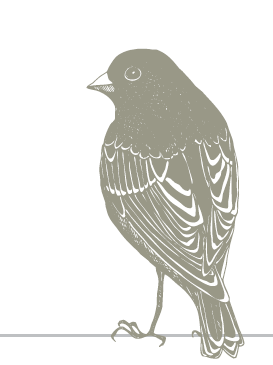
|
 www.atree.org www.atree.org |
Head Office
Bangalore
Royal Enclave, Sriramapura
Jakkur Post, Bangalore 560 064
Tel: +91-80-23635555,
Fax: +91-80-23530070
Regional offices
Eastern Himalayas
Khangsar House,
Above Brahmakumari, Development Area
Gangtok 737101
Tel: +91-3592-206 403
New Delhi
C-86, 2nd floor,
B K Dutt Colony,
New Delhi 110003
Tel no: 011-24603134
Governing Board
Dr. Kamaljit S. Bawa ( Chairman)
Dr. K. N. Ganeshaiah
Dr. R. Uma Shaanker
Mr. Darshan Shankar
Ms. Rohini Nilekani
Dr. Surinder M. Sehgal
Ms. Seema Paul
Ms. Pheroza J. Godrej
Dr. K. S. Jagadish
Mr. A. N. Singh
Dr. S. Natesh
Dr. Ganesan Balachander( ex-officio)
Dr. Priyadarsanan Dharma Rajan
( faculty)
Executive Committee
Dr. Ganesan Balachander ( Chair)
Dr. Ankila Hiremath ( Faculty representative)
Dr. Abi Tamim Vanak ( Faculty representative)
Dr. Sharachchandra Lele ( ex officio)
Dr. Jagdish Krishnaswamy ( ex officio)
Dr. Nitin Rai ( ex officio) |
Advisory Board
Pl note: * will also serve on the Faculty Advisory Committee
* Dr. Vijay Raghavan, Director, National Centre for Biological Sciences, Bengaluru
Dr. Raghavendra Gadagkar, INSA SN Bose Research Professor and JC Bose National Fellow, Centre for Ecological Sciences, Bengaluru
* Dr. Amita Baviskar, Associate Professor, Institute of Economic Growth, Delhi
* Dr. Navroz K. Dubash, Senior Fellow, Centre for Policy Research, New Delhi
* Dr. Gita Sen, Professor, Centre for Public Policy, Indian Institute of Management, Bengaluru
Mr. Raj Khoshoo, Senior Vice President, Siemens PLM, CA, USA
Ms. Kalpana Sharma, independent journalist, Mumbai
Dr. Ravi Chopra, Director, People's Science Institute, Dehradun, Uttarakhand
* Dr. S. P. Singh, Former Vice Chancellor, Advisor, State Planning Commission, Government of Uttarakhand, Dehradun, Uttarakhand
Dr. Ramesh Singh, Director, Learning, Monitoring and Evaluation, Office of the Director of Programs, Open Society Institute, New York
Convenors and Programme Leaders
Dr. Jagdish Krishnaswamy,
Ecosystem Services and Human Well-being and Convenor, Suri Sehgal Centre for Biodiversity and Conservation
Dr. Sharachchandra Lele,
Forests and Governance and Convenor, Centre for Environment and Development
Dr. Priyadarsanan Dharma Rajan and Dr. Ankila Hiremath,
Ecosystems and Global Change
Dr. Shrinivas Badiger
Land Water and Livelihoods
Academy
Dr. Nitin Rai,
Convenor, Academy for Conservation Science and Sustainability Studies
This newsletter has been put together from reports by ATREE folk. Design and lay out is by Salil Sakhalkar. Editing by Samuel Thomas, Ganesan Balachander and Meetu Desai. |
|

